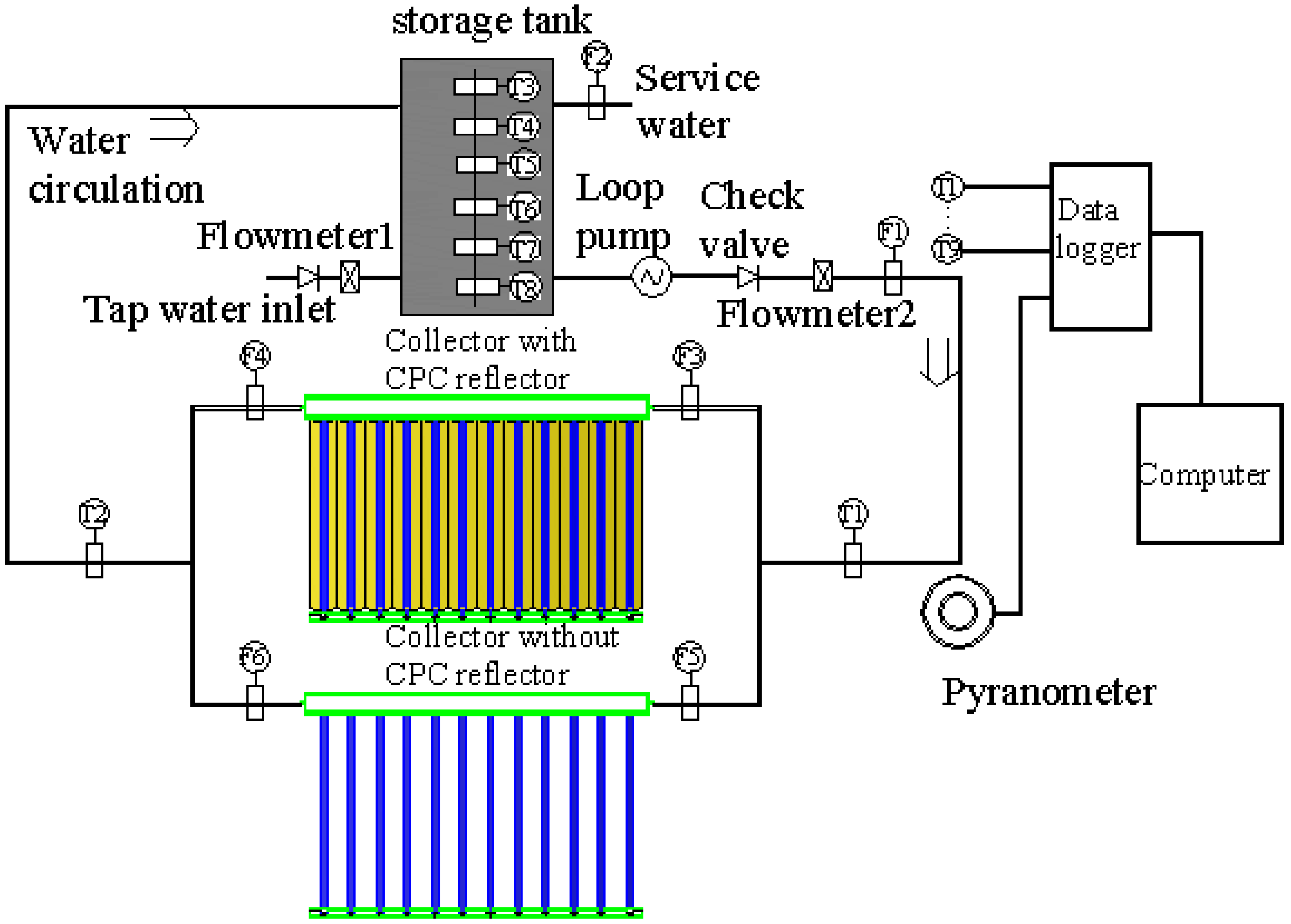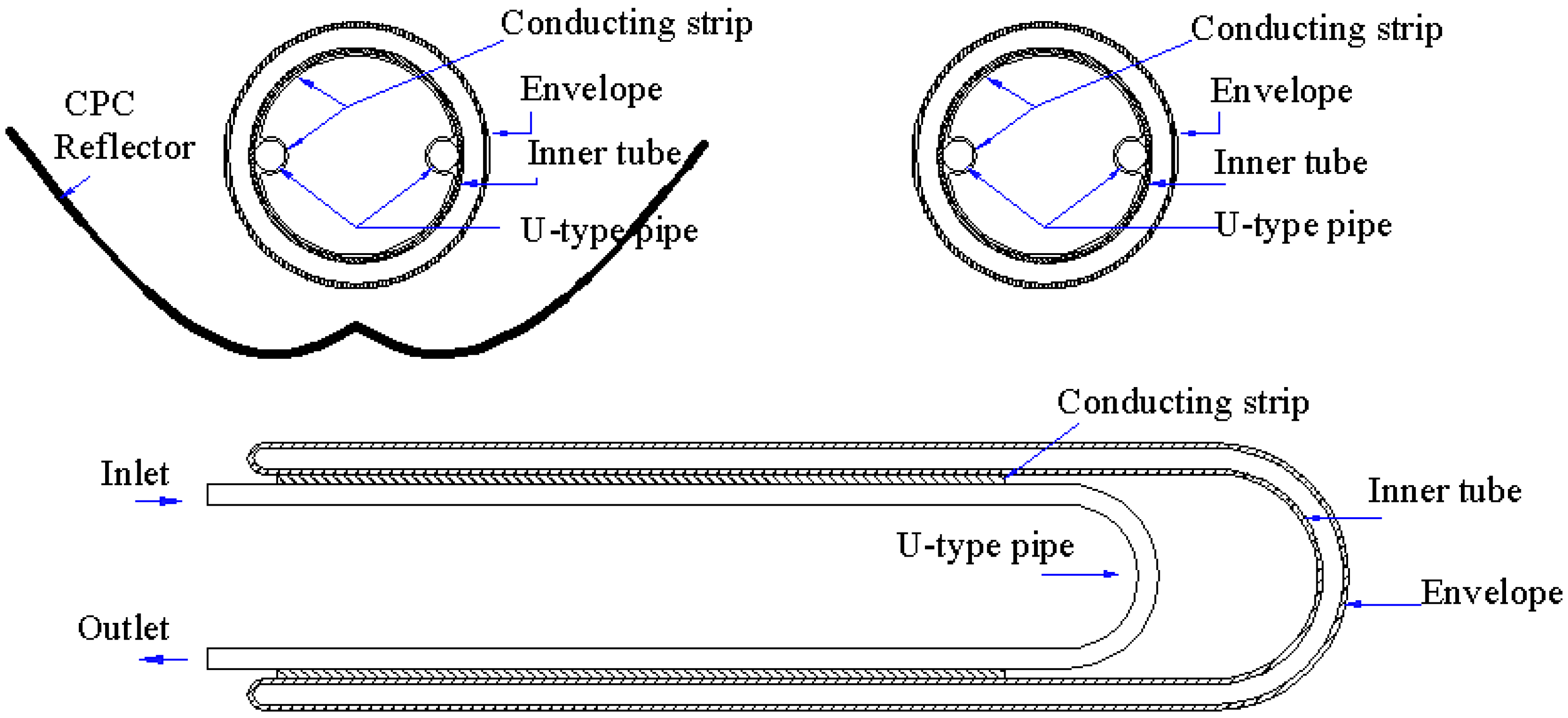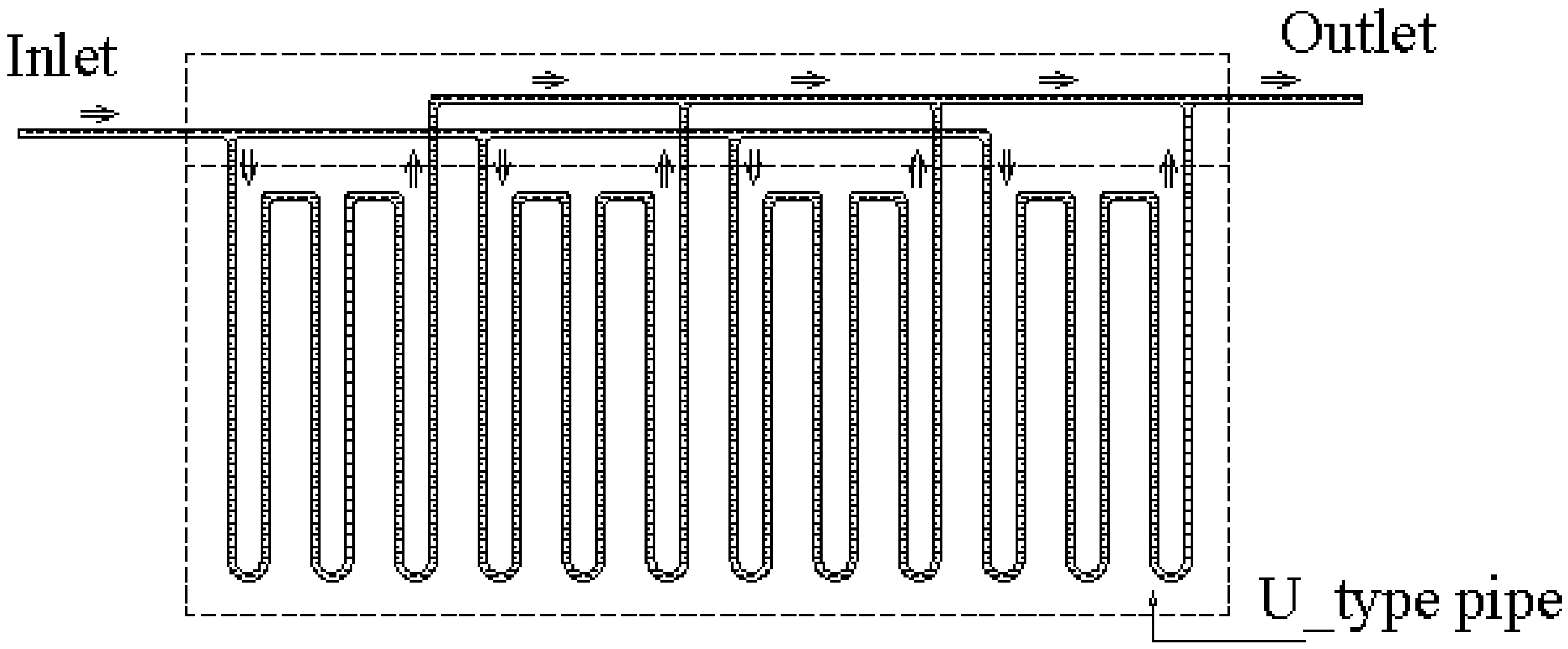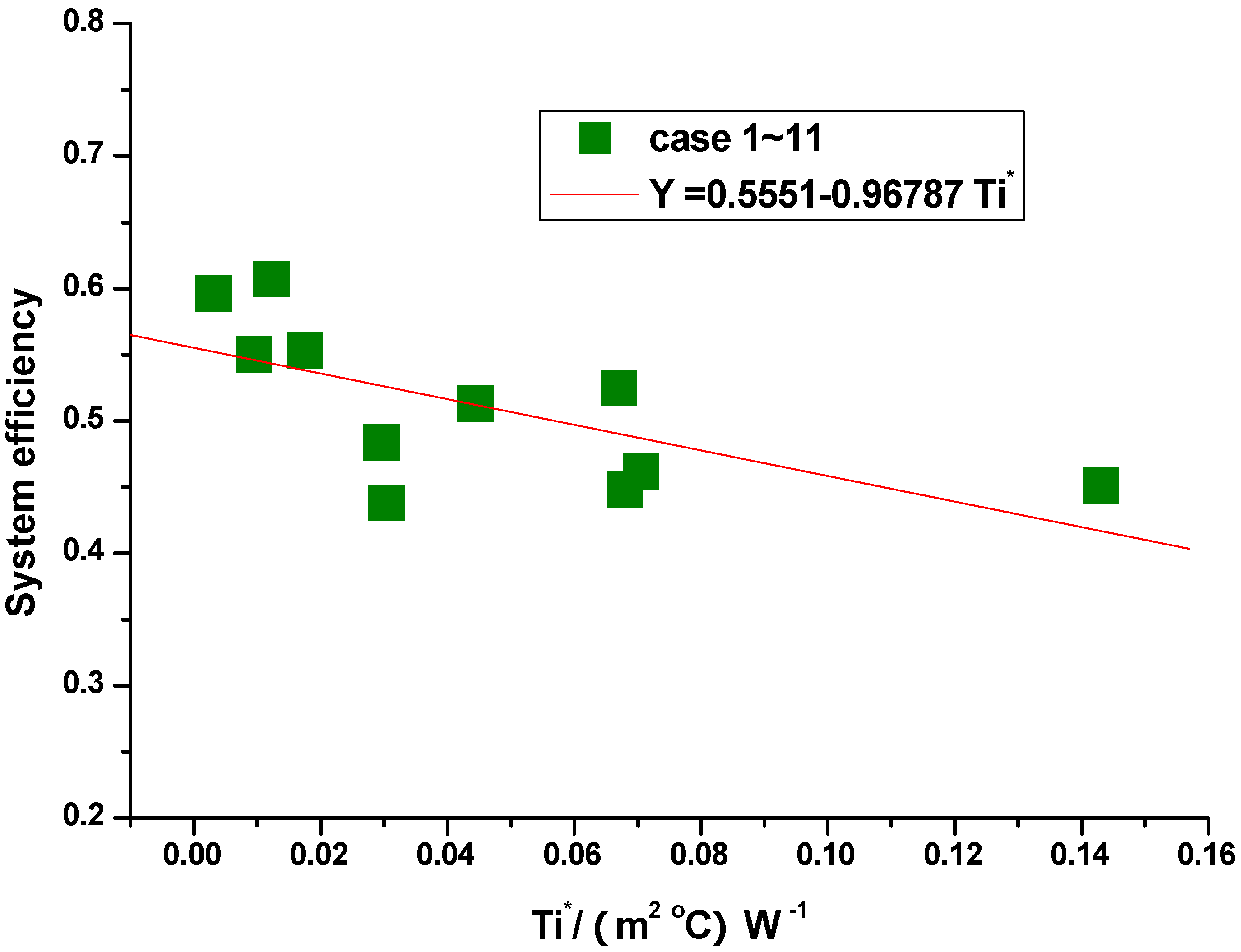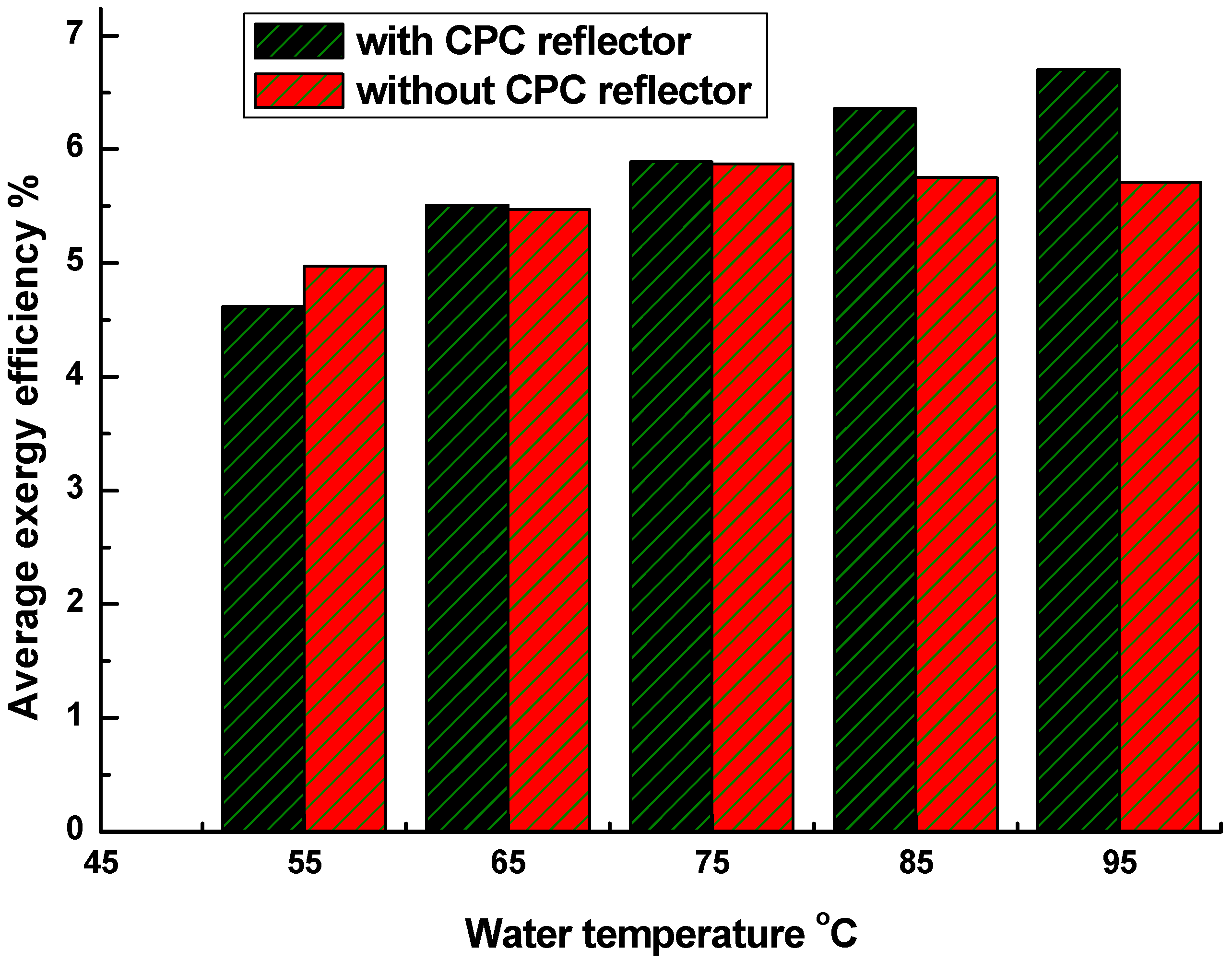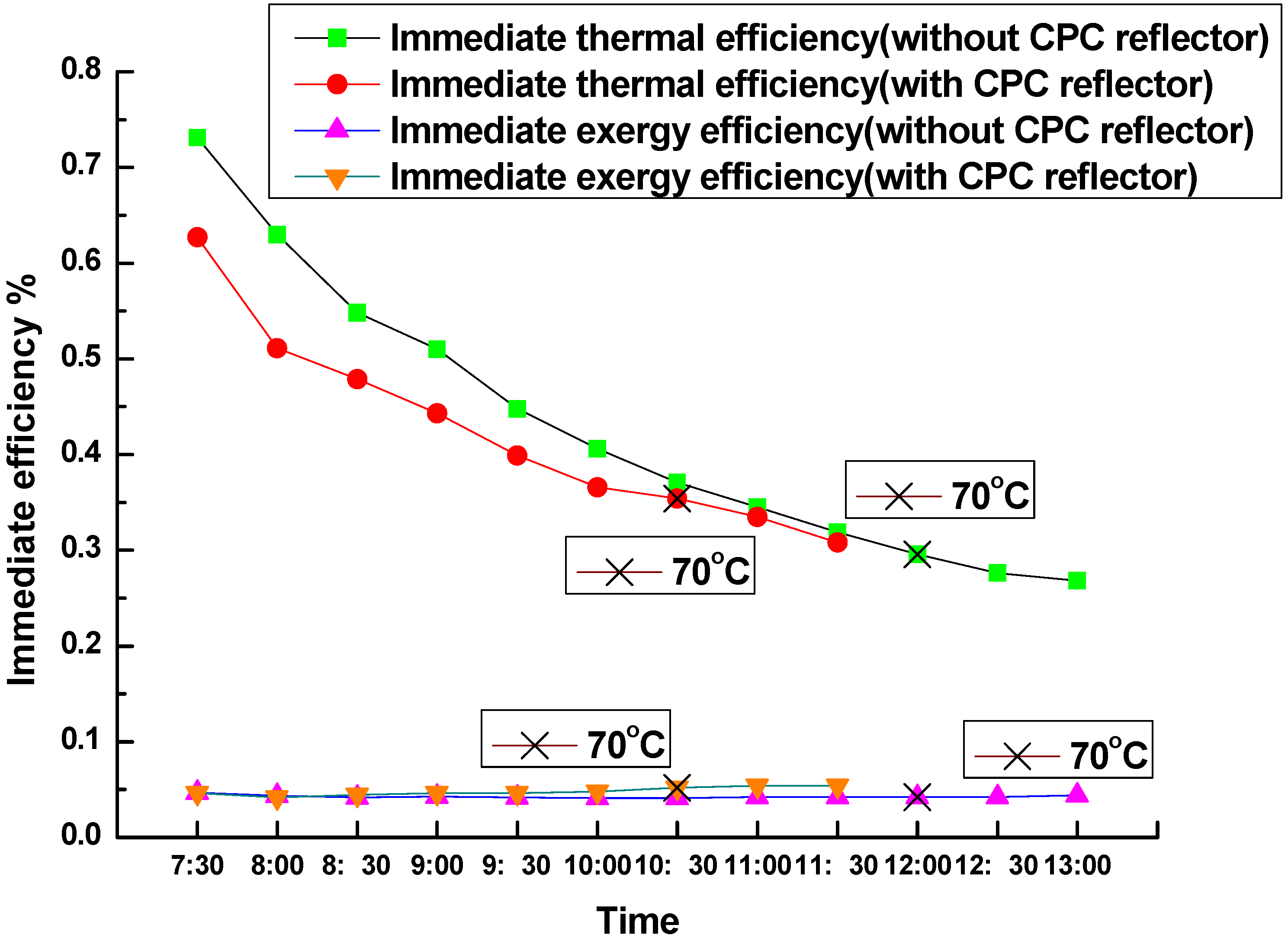1. Introduction
Evacuated tube solar water heater systems are widely used in China. Their advantages include their high thermal efficiency, simple construction requirements, and low manufacturing costs. In recent years, a number of studies have been conducted on evacuated tube solar water heater systems. Budihardjo
et al. [
1,
2,
3] investigated their components such as collector optical efficiency, collector heat loss, storage tank heat loss, and natural circulation flow rate through collector tubes. Kim
et al. [
4] studied glass evacuated tubes with a coaxial fluid conduit inserted in each tube using a one-dimensional model. Han
et al. [
5] performed a three-dimensional performance analysis using computational fluid dynamics. Kim
et al. [
6] examined four different shapes of absorber tube such as finned tubes, a U tube welded inside a circular fin, a U tube welded on a copper plate, and a U tube welded inside a rectangular duct using a numerical method, and they found the best absorber tube shape for a solar collector. Ma [
7], Liang [
8], and Duffie [
9] analyzed the thermal performance of a glass evacuated tube solar collector based on the energy balance for a U tube glass evacuated tube solar collector. With the rapid advancements in society, a higher temperature is needed in a number of applications such as air conditioning, refrigeration, building heating, sea water desalination, and industrial heating, among others. Evacuated solar collectors do not only supply domestic hot water or heating (below 60 °C), but they can also operate as solar pre-heaters with a boost tank, an instantaneous gas heater, or a single-tank system with a boost element incorporated in the solar tank for higher-temperature application fields (above 60 °C).
The performance of the evacuated tube solar water heater system is affected by its design and operation, and by environmental factors. Currently, concentrated solar collectors are used widely because of their stable performance. In terms of solar water heater systems, CPC is undoubtedly the best choice because it does not need a tracking system, and it can decrease the cost of moving parts if the concentration ratio is low. Rabl [
10] and Tchinda
et al. [
11] examined a detailed thermal performance of a CPC with a flat, one-sided absorber [
12] and a CPC with a straight-through evacuated tube [
13].
Evacuated tube solar water heater systems with and without CPC reflectors have their respective advantages and application scopes. The former generally provides hot water or floor heating energy, whereas the latter provides higher temperature for other applications, such as industrial washing. The two types of heating systems have different performance advantages after attaining different heating temperatures. According to the definition of Mills [
14], the geometrical concentration ratio
C can be expressed as:
where
W is the slot top width and
r is the radius of the evacuated tube.
O’Gallagher [
15] and Sharma [
16]
et al. studied the advantages of the different types of CPC-evacuated tube solar receivers. However, the geometrical concentration ratio
C is almost always greater than one or equal to one. CPCs with a geometrical concentration ratio
C of less than one are rare. In practical applications, a CPC will always be truncated for economic reasons [
10]. Thus, a mini-CPC offers more economic advantages. The mini-CPC can also be easily transported, easily installed and maintained for domestic application, and the reflectors cannot be easily deformed or broken, making it more suitable for business promotion. Therefore, a study of the mini-CPC (
C < 1) evacuated tube solar water heater system is significant.
Exergy analysis is a powerful tool that has been used widely in the performance analysis of solar water heater systems. It can detect and evaluate quantitatively the maximum useful work that can be done by a solar water heater. Xiaowu and Ben [
17] performed exergy analysis for a domestic-scale solar heater. Gunerhan and Hepbasli [
18] performed an exergetic modeling and performance evaluation of a solar water heating system for building applications.
In this paper, a comparison of the experimental rig of evacuated tube solar water heater systems with and without a mini-CPC(C < 1) reflector was conducted for introducing the performance of SWH with the mini-CPC better, with a series of comparative experiments done in Hefei, China. The first and second laws of thermodynamics were used to analyze and contrast the thermal performance of the two systems with and without a mini-CPC reflector.
The water in the tank was heated from 26.9 to 55, 65, 75, 85, and 95 °C using the two types of solar water systems. The average thermal and exergy efficiencies of the two systems were analyzed. Moreover, the data gathered for two days were compared. The initial and final water temperatures of them were similar respectively. The immediate thermal and exergy efficiencies of the two systems were also analyzed.
The changes or differences in the performance led by the mini-CPC are clearly seen through a comparative experimental study and exergetic analysis of their thermal performance. When the temperature requirement in applications is low, the evacuated tube solar water heater system without a mini-CPC reflector offers some advantages. On the other hand, when the temperature requirement in applications is high, the evacuated tube solar water heater system with a mini-CPC reflector is more suitable.
4. Experimental Results and Discussion
The thermal efficiencies of SWH system with mini-CPC in case 1–11 were fitted to a linear function to correspond to mutual relationships among the variables, as shown in
Figure 4.
Figure 4.
Thermal efficiency fit curve of the experimental results solar water heater system with mini-CPC.
Figure 4.
Thermal efficiency fit curve of the experimental results solar water heater system with mini-CPC.
The thermal efficiency equation is as follows:
Using this equation, the thermal efficiency intercept was 0.5551, and the coefficient of total heat loss was small at only 0.96787 W/(m2·°C).
To order to introduce the changes or differences led by the mini-CPC and express the performance more clearly, the two series of comparison experiment was made. The first series is that the evacuated tube solar water heater systems with and without mini-CPC reflectors were used to heat water from 26.9 °C to 55, 65, 75, 85, and 95 °C under similar environmental conditions and the average thermal efficiency as well as the average exergy efficiency of the five groups experiments were contrasted. The second series is that we chose the experimental data on April 18 and 20 due to the fact the environmental parameters during the tests of the two days were similar and their immediate thermal and exergy efficiency were contrasted. The two series of the comparison experiments were independent.
In the first series of comparison experiments, the pressure drop from water inlet to outlet is about 0.1 MPa. In the present experiment, the average irradiation density and average environment temperature of the evacuated tube solar water heater system without a mini-CPC were 695 W/m2 and 18.1 °C, respectively, and the average irradiation density and average environment temperature of the evacuated tube solar water heater system with a mini-CPC were 671 W/m2 and 16.0 °C, respectively. Based on the data, the average irradiation density and average environment temperature of the evacuated tube solar water heater system without a mini-CPC reflector was slightly higher than those of the system with a mini-CPC reflector. However, the environmental parameters in the series of experiments show that the difference in test environmental conditions is not significant and that the environmental conditions are stable.
From
Figure 5, it can be seen that when the temperature of the obtained hot water is 55, 65, and 75 °C, the average thermal efficiency of the evacuated tube solar water heater system without a mini-CPC reflector is higher than that of the system with a mini-CPC reflector. However, when the temperature of the obtained hot water is 85 and 95 °C, the average thermal efficiency of the former is lower than that of the latter. Further, the average thermal efficiency of the evacuated tube solar water heater system with a mini-CPC reflector decreases slower and is more stable than that of the solar water heater system without a mini-CPC reflector.
Figure 5.
Average thermal efficiency of the five groups of comparison experiments.
Figure 5.
Average thermal efficiency of the five groups of comparison experiments.
It is shown in
Figure 6 that the average exergy efficiency of the five groups of comparison experiments with water temperatures of 55, 65, 75, 85, and 95 °C, respectively. When the temperature of the hot water is high, the average exergy efficiency is also high; this trend is opposite that of the average thermal efficiency. The average exergy efficiency growth trend of the evacuated tube solar water heater system with a mini-CPC reflector is obvious, with its average exergy efficiency increasing initially, and then maintaining stability. Further, when the temperature of the water is low, such as at 55 °C, the average exergy efficiency of the evacuated tube solar water heater system with a mini-CPC reflector is lower than that of the system without a mini-CPC reflector. However, when the temperature of the water is high, such as at 85 and 95 °C, the average exergy efficiency of the former is larger than that of the latter.
Figure 6.
Average exergy efficiency of the five groups of comparison experiments.
Figure 6.
Average exergy efficiency of the five groups of comparison experiments.
From
Figure 5 and
Figure 6, the advantages of both systems are evident. When the final required water temperature is low, such as below 75 °C which is suitable for residential hot water and floor heating, among others, the evacuated tube solar water heater system without a mini-CPC reflector presents obvious advantages. However, when the final water temperature required is high, such as above 75 °C which is suitable for heat sink heating and industrial washing, among others, the evacuated tube solar water heater system with a mini-CPC reflector presents significant advantages.
To explain further these advantages, the second series comparison experiments test results of the evacuated tube solar water heater system without a mini-CPC reflector on 18th April (producing 65 L of hot water) and those of the evacuated tube solar water heater system with a mini-CPC reflector on April 20 (producing 85 L of hot water) were analyzed and compared.
The evacuated tube solar water heater systems with and without a mini-CPC reflector were parallel, and they were tested individually to reduce the influence of non-collector parts. The environment parameters during the tests were similar so that the comparison of results can be significant.
From
Figure 7, the irradiation density on 18th April is slightly higher than that on 20th April, but the environment temperature is slightly lower. During the test, the temperature of the water in the tank was heated from 35.5 ± 1 °C to 80.8 ± 1 °C. The test using the evacuated tube solar water heater system without a mini-CPC reflector on 18th April began at 7:30 AM and was completed at 13:05. Therefore, the irradiation fluctuation in the afternoon did not affect the test. Meanwhile, the test using the evacuated tube solar water heater system with a CPC reflector on 20th April began at 7:30 AM and was completed at 11:30 AM. So the date after 11:30 AM is also not important.
Figure 8 shows the immediate thermal and exergy efficiencies on 18th April and 20th April. During the test, the immediate efficiencies of the evacuated tube solar water heater systems with and without a mini-CPC reflector show a clear downtrend. In the initial stage, the immediate efficiency of the evacuated tube solar water heater system without a mini-CPC reflector is higher than that of the system with a mini-CPC reflector.
Figure 7.
18th April and 20th April environment parameters.
Figure 7.
18th April and 20th April environment parameters.
Figure 8.
Immediate efficiency on 18th April and 20th April.
Figure 8.
Immediate efficiency on 18th April and 20th April.
However, the former immediate thermal efficiency curve declines rapidly. Therefore, when the water temperature in the tank is high, the immediate thermal efficiency of the evacuated tube solar water heater system without a mini-CPC reflector is lower than that of the system with a mini-CPC reflector. As shown in
Figure 7, when the water temperature in the tank is 70 °C, the immediate thermal efficiency of the evacuated tube solar water heater system without a mini-CPC reflector is 29.6%, whereas that of the system with a mini-CPC reflector is 35.4%. Therefore, the increase in temperature in high-temperature applications using the evacuated tube solar water heater system with a mini-CPC reflector is faster if the quality of the water heated is the same.
On the other hand, the immediate exergy efficiencies of the two systems maintain their stability and increase slightly. When the water temperature in the tank is high, such as 70 °C, the immediate exergy efficiency of the evacuated tube solar water heater system without a mini-CPC reflector is lower than that of the system with a mini-CPC reflector. Therefore, a higher quality of heat energy using the evacuated tube solar water heater system with a mini-CPC reflector can be obtained when a higher water temperature is required.
5. Conclusions
A comparison of the experimental rig of evacuated tube solar water heater systems with and without a mini-CPC reflector was conducted. The results of the comparative tests were presented. The other parts of the two solar water heater systems were all the same, except the solar collectors.
When attaining low water temperatures, the evacuated tube solar water heater system without a mini-CPC reflector has higher thermal and exergy efficiencies regardless of the average or immediate values. When attaining high water temperatures, the evacuated tube solar water heater system without a mini-CPC reflector has lower thermal and exergy efficiencies regardless of the average or immediate values.
Therefore, the evacuated tube solar water heater system without a mini-CPC reflector is more suitable for applications requiring low temperature, such as residential hot water and floor heating, among others. Meanwhile, the evacuated tube solar water heater system with a mini-CPC reflector is more suitable for applications requiring a high temperature, such as air conditioning, refrigeration, building heating, sea water desalination, and industrial heating, solar low-temperature heat power generation among others. In addition, the mini-compound parabolic concentrator, due to the mini-structure, has some advantages on the structure stability, the transportation convenience and installation of the immobility and so on. The evacuated tube solar water heater system with a mini-CPC reflector is still based on the existing evacuated tube solar water heater, so no matter the cost or use methods, it is also easier to popularize for distributed or integrated engineering application.
